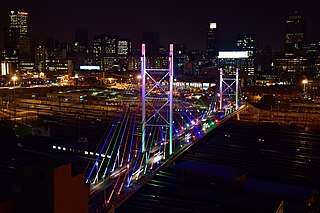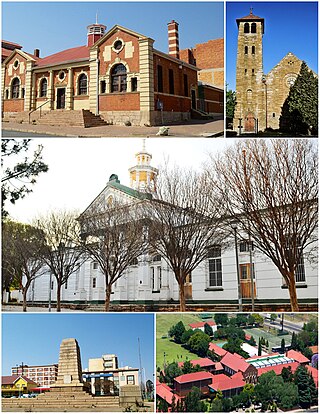
Johannesburg is the most populous city in South Africa with 4,803,262 people, and is classified as a megacity; it is one of the 100 largest urban areas in the world. It is the provincial capital of Gauteng, the wealthiest province in South Africa. Johannesburg is the seat of the Constitutional Court, the highest court in South Africa. Most of the major South African companies and banks have their head offices in Johannesburg. The city is located within the mineral-rich Witwatersrand hills, the epicentre of the international-scale mineral, gold and (specifically) diamond trade.

Johannesburg is a large city in Gauteng Province of South Africa. It was established as a small village controlled by a Health Committee in 1886 with the discovery of an outcrop of a gold reef on the farm Langlaagte. The population of the city grew rapidly, becoming a municipality in 1898. In 1928 it became a city making Johannesburg the largest city in South Africa. In 2002 it joined ten other municipalities to form the City of Johannesburg Metropolitan Municipality. Today, it is a centre for learning and entertainment for all of South Africa. It is also the capital city of Gauteng.

Boksburg is a city on the East Rand of Gauteng province of South Africa. Gold was discovered in Boksburg in 1887. Boksburg was named after the State Secretary of the South African Republic, W. Eduard Bok. The Main Reef Road linked Boksburg to all the other major mining towns on the Witwatersrand and the Angelo Hotel (1887) was used as a staging post.
Heriotdale is a suburb of Johannesburg, South Africa. The suburb lying south of Malvern and north of Rosherville, is an industrial area. It is located in Region F of the City of Johannesburg Metropolitan Municipality.
Salisbury Claims is a suburb of Johannesburg, South Africa. It is located in Region F of the City of Johannesburg Metropolitan Municipality.
Maoupa Cedric Maake, known as the Wemmer Pan Killer, is a South African serial killer who was convicted of 27 murders but was suspected of killing many more.

The N17 is a national route in South Africa which runs from Johannesburg to Oshoek (Ngwenya) on the border with Eswatini. It passes through Springs, Bethal and Ermelo.

Molteno is a town in the Eastern Cape province of South Africa.

James Hall Museum of Transport is a transport museum that aims to preserve and promote the history of over 400 years of transport in South Africa in particular, and Africa in general. It is the largest transport museum in Africa. It is located at Pioneers' Park beside the Wemmer Pan in La Rochelle, Johannesburg, South Africa. It was established in 1964 by Jimmie Hall and the City of Johannesburg.

Wemmer Pan is a lake and recreational area in Johannesburg, South Africa. It's located to the south of the city centre, in the suburb of La Rochelle.
Colonel Ignatius Philip Ferreira, was a South African soldier, fortune hunter, miner and farmer of Portuguese descent. He is more commonly known for having the earliest gold mining camp on the Witwatersrand named after him called Ferreirastown (Ferreirasdorp), which was on the edge of the farm Randjeeslagte soon to be proclaimed as the site of a new town called Johannesburg.

The Empire Exhibition, South Africa, held in Johannesburg, was intended to mark that city's jubilee and was opened by the Governor-General of the Union of South Africa on 15 September 1936. It was the first exhibition held in the Union of South Africa following two earlier exhibitions in Cape Colony in 1877 and 1892. The idea of an empire exhibition in South Africa was first discussed in 1934 by the Buy Empire Committee of Johannesburg. On 9 January 1935, the Grand Council of the Federation of British Industries passed a resolution for a proposal to hold an Empire Exhibition in Johannesburg in 1936 in conjunction with the Golden Jubilee of the city.
Boysens is a suburb of Johannesburg, South Africa, located around 3.2 km southwest of city hall.
Claremont is a suburb of Johannesburg, South Africa, around 9 km west-northwest of City Hall. Under the old municipal borders, it was one of the westernmost suburbs of the city and bordered Roodepoort.
Rouxville is a suburb of Johannesburg, South Africa, around 8 kilometres (5.0 mi) northeast of City Hall.
Talboton is a suburb of Johannesburg, South Africa, around 7 km northeast of City Hall.
Unigray is a suburb of Johannesburg, South Africa, around 6 km southeast of City Hall. It lies north of Queenshaven, east of Elladoone, and west of Electron.
Victory Park is a suburb of Johannesburg, South Africa, around 8 km northwest of City Hall.
Village Deep is a suburb of Johannesburg, South Africa, around 1.3 km south of City Hall. It is an industrial suburb one kilometer from north to south and less than 300 meters from east to west. To the west is the Genesis Landfill Facility, to the south is the railway and Stafford, to the east is Eloff Street, to the southeast is Robinson Deep, to the northeast is Selby, and to the north is New Centre. Village Deep was founded on February 14, 1934, on Turffontein and Booysen Estate farms. The name, which was originally The Village, comes from the nearby Village Deep Levels gold mine.

Wemmerpan Commando was a light infantry regiment of the South African Army. It formed part of the South African Army Infantry Formation as well as the South African Territorial Reserve.









